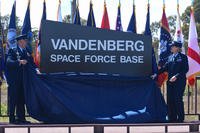HANSCOM AIR FORCE BASE, Mass. -- An Air Force program at Hanscom Air Force Base that continually provides critical imagery to warfighters and first responders, is also reducing costs.
Eagle Vision consists of five deployable satellite downlink stations that collect, process and distribute commercial satellite imagery in nearly real time. The data not only can be used to highlight areas of interest for U.S. or coalition warfighters in the field, but also for disaster response efforts.
"As soon as the tornadoes struck in Moore, Okla., the team went to work," said Capt. Chris Berardi, the program manager. "Despite being in the middle of a tech refresh, where system equipment was being upgraded, the team turned their attention to ensuring (the Federal Emergency Management Agency), the National Guard and (U.S. Northern Command) got the required imagery they needed."
Although cloud cover hampered some efforts, data was provided within 72 hours of the initial event. Berardi emphasized that the commercial imagery that is provided can be freely shared between organizations.
When a tornado touched down once again in Oklahoma on May 31, the program office immediately put their assets to work again. Usable imagery denoting the path of the tornado, as well as the extent of flooding in the area, was provided to first responders within 48 hours of the event.
In addition to ongoing military applications for the imagery, the team is also currently providing support to those battling wildfires in New Mexico. The U.S. Forest Service requested EV imagery after fires broke out near Tres Lagunas, N.M., also on May 31. Currently the fires have burned approximately 10,000 acres and are only minimally contained. Before and after imagery was provided within days.
According to program officials, the organizations often use the imagery for damage assessment.
"The different types of imagery, such as high-resolution, electro-optical imagery and synthetic aperture radar, we can provide are helpful as well," Berardi said.
The technological refresh that Berardi refers to is part of the largest upgrade in the Eagle Vision system's history. New satellite constellations are being added, antenna upgrades are being implemented and new shelters are being provided to house the equipment.
Although the majority of this work is being funded by the National Guard, Berardi said the team is always looking for cost savings. The program office has also performed an analysis on all Eagle Vision satellite providers.
"We needed to determine if what we were getting was worth what we were paying out," Berardi said.
The results led to the elimination of one constellation of satellites, for yearly savings of $610,000.
They also looked at redundant capabilities. The team was able to identify some redundancies within the software architecture and processing capabilities.
"Sequestration is causing everyone to look at what they're spending very carefully," Berardi said. "We need to ensure we're still able to provide the necessary imagery but do so in a more efficient and effective manner."
Eagle Vision is reviewing all current and planned acquisitions to determine if other cost savings are available.
"We are looking at all options, including cost avoidance analyses, to identify further cost reduction opportunities," Berardi said. "Ultimately, these are savings for the taxpayer."
He stressed that the cost savings initiatives would not negatively impact the program office's ability to respond when needed.
"We know how important the capability to provide this imagery is," Berardi said.

























